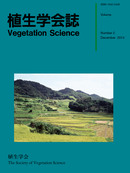Volume 16, Issue 2
Displaying 1-6 of 6 articles from this issue
- |<
- <
- 1
- >
- >|
-
Article type: Article
1999 Volume 16 Issue 2 Pages 103-113
Published: December 25, 1999
Released on J-STAGE: January 06, 2017
Download PDF (1042K) -
Article type: Article
1999 Volume 16 Issue 2 Pages 115-129
Published: December 25, 1999
Released on J-STAGE: January 06, 2017
Download PDF (2045K) -
Article type: Article
1999 Volume 16 Issue 2 Pages 131-140
Published: December 25, 1999
Released on J-STAGE: January 06, 2017
Download PDF (1127K) -
Effects of ammonium sulfate on vegetation on ski runs subjected to differing degrees of landscaping.Article type: Article
1999 Volume 16 Issue 2 Pages 141-147
Published: December 25, 1999
Released on J-STAGE: January 06, 2017
Download PDF (1017K) -
Article type: Article
1999 Volume 16 Issue 2 Pages 149-158
Published: December 25, 1999
Released on J-STAGE: January 06, 2017
Download PDF (977K) -
Article type: Article
1999 Volume 16 Issue 2 Pages 159-167
Published: December 25, 1999
Released on J-STAGE: January 06, 2017
Download PDF (983K)
- |<
- <
- 1
- >
- >|
